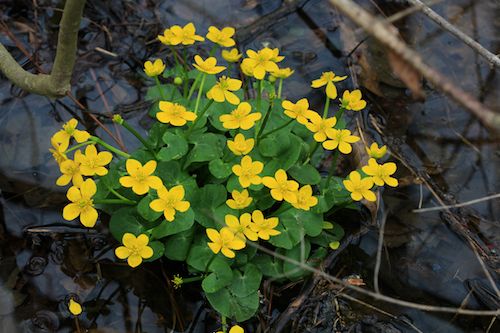Citizen Science: Distribution of Look-Alike Buttercups
Happy Earth Day!
I usually offer some things to think about on Earth Day: reduce, reuse, recycle, purchase wisely, buy fresh/buy local, volunteer, support conservation organizations, plant native species, let your yard go a little wild, etc. And most importantly, get out and enjoy nature!
This year I’ll add another: participate in some citizen science. Here is one project to which I recently contributed:
You know that beautiful yellow flower that is carpeting local forests, particularly in the floodplains of streams and rivers? It is an invasive plant called lesser celandine, or by its botanic name: Ranunculus ficaria. Beautiful it may be, but because it so thoroughly carpets the floor of the woods, it is displacing a diversity of the native spring wildflowers that would otherwise grow there: trout lily, anemones, bloodroot, spring beauty, Dutchman’s breeches, trilliums, and native orchids, to name a few.
This is one species that I found a small population of at Crow’s Nest several years ago—about 25 plants. I have been working to get rid of them before they expand to fill our floodplain woods. Last year I found no new individuals (the location, on the way to the creek trail, is permanently flagged). But this year I found three, so I removed them promptly. This is the best example I have of “EDRR”: Early Detection—Rapid Response. It is much easier to manage an invasive species very early in the invasion process than once it is already covering acres of ground.
Several years ago I also found at Crow’s Nest Preserve a population of the native wildflower, marsh marigold (Caltha palustris):
It is superficially similar-looking, but has only five petals vs. lesser celandine’s eight, and it grows in clumps in wetlands rather than carpeting the ground completely. Our marsh marigold is growing in the standing water of vernal wetlands. Lesser celandine grows in wet floodplain woods but probably not in open water.
There is a citizen science project on to document the range and extent of these two species. Interestingly there are populations of both species locally that are separate but very close. Lesser celandine has shown up along the Horse-Shoe Trail on properties adjacent to (but fortunately for me, downstream from) Crow’s Nest Preserve. Marsh marigold grows in a wetland just a few hundred yards away on the preserve’s land. It’s an easy place to compare the species, their habitats, and perhaps the circumstances under which one site has been invaded and the other not.
I submitted my photos and records to the project on iNaturalist.org. You can too!
Posted by Daniel Barringer on April 22, 2013.


